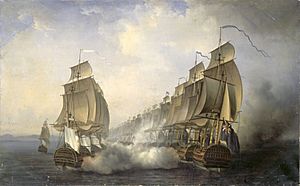Battle of Cuddalore (1783) facts for kids
Quick facts for kids Battle of Cuddalore |
|||||||
|---|---|---|---|---|---|---|---|
 The Battle of Cuddalore, Auguste Jugelet |
|||||||
|
|||||||
| Belligerents | |||||||
| Commanders and leaders | |||||||
| Strength | |||||||
| 15 ships of the line | 18 ships of the line | ||||||
| Casualties and losses | |||||||
| 478 killed and wounded | 533 killed and wounded | ||||||
The Battle of Cuddalore was a big naval fight in 1783. It happened off the coast of India. The battle was between the British navy and the French navy.
The British fleet was led by Admiral Sir Edward Hughes. The French fleet was smaller and led by Admiral Suffren. This battle took place just before a peace treaty was signed in Europe. That treaty officially ended the American Revolutionary War.
The fight happened near Cuddalore on June 20, 1783. Admiral Suffren led his ships from the frigate Cléopâtre. The French won this battle. The news of peace had not yet reached India. This made the Battle of Cuddalore the very last battle of that war.
After the battle, the British fleet went back to Madras. This stopped them from sending more soldiers to Cuddalore. A surprise attack from Cuddalore also weakened the British forces. Finally, on June 29, news of the peace treaty arrived. Both sides agreed to stop fighting on July 2.
Contents
Why the Battle Happened
British Plans for Cuddalore
After the French ally Hyder Ali died in December 1782, the British saw a chance. Hyder Ali was the ruler of Mysore. He used to control Cuddalore. British leaders in Madras decided to try and take Cuddalore back.
Their army marched south from Madras. They went around the city and set up camp. The British navy also arrived. Eighteen warships under Admiral Sir Edward Hughes anchored south of Cuddalore. Their job was to protect the army and its supply ships. By early June 1783, the Siege of Cuddalore had begun.
French Support for Cuddalore
French Admiral Suffren was ordered to help. On June 10, he sailed with his smaller fleet of fifteen ships. They left Trincomalee to support the city under attack.
When Suffren arrived, Admiral Hughes tried to avoid a fight. He moved his ships away from the city and anchored again. For five days, the winds were tricky. Finally, Suffren was able to anchor near Cuddalore. He connected with the city's commander, Sayed Sahib.
It looked like the navy would decide the siege. So, 1,200 soldiers from the city joined Suffren's ships. This helped them have more people to fire the cannons. Suffren's fleet then set sail on June 18. Both fleets began to move, trying to get the best position for battle.
The Battle Begins
At first, light and changing winds made it hard for both fleets. They couldn't get into a good fighting position. But on June 20, a steady west wind started blowing.
Admiral Hughes lined up his ships for battle. He waited for Suffren to make the first move. Suffren also lined up his ships in a similar way. He then gave the order to attack. The battle started shortly after four in the afternoon.
The fighting lasted for about three hours. Even though all the ships were involved, none were badly damaged.
After the Battle
After the fight, Suffren's fleet anchored about 25 miles north of Cuddalore. Hughes anchored closer to the city. On June 22, Hughes saw the French fleet while he was sailing to Madras. Many of his ships were damaged. He also reported that many of his sailors were sick with scurvy. They were also running low on fresh water.
Suffren returned to Cuddalore on June 23. This forced the British supply ships to leave. He also returned the 1,200 soldiers he had borrowed. Plus, he landed another 2,400 men to help defend the city.
The British tried to attack from the city, but they were pushed back. This weakened the British forces even more. On June 29, a British ship arrived under a truce flag. It brought the news of a peace agreement between France and Britain. Both sides then agreed to stop fighting on July 2.
Ships in the Battle
The battle involved many warships. The French had 15 ships of the line. The British had 18 ships of the line. These were large ships with many cannons.
- French Fleet:
- 15 ships of the line
- 3 frigates (smaller, faster ships)
- Total casualties: 478 killed and wounded
- British Fleet:
- 18 ships of the line
- 6 frigates and other smaller ships
- Total casualties: 533 killed and wounded


